Description
Lycoris (or spider lily) is a bulbous plant. The flower is thermophilic, therefore it does not tolerate cold and frost
It is important to consider this characteristic when choosing a planting site - if you live in the northern regions, then you should refuse to grow licoris
The plant is quite large - the diameter of the bulb is about 5 centimeters, while the leaves reach 40 centimeters in length and 20 centimeters in width. Lycoris leaves belong to the belt-like category, as they are very narrow. Moreover, they have a bright and rich green color.
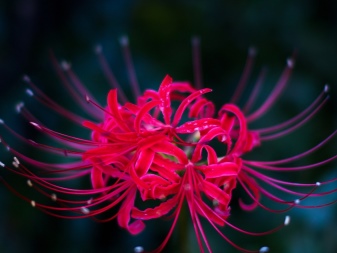

At the top of the stem, which has a rounded section, inflorescences with large buds appear over time
It is important to note (and for this quality lycoris are especially appreciated by gardeners) that from 4 to 7 flowers can appear on one stem. A distinctive feature of lycoris flowers is a pronounced aroma
The flowering process begins in early September.
The shape of the lycoris flowers is rather unusual and very peculiar. So, the petals are similar in appearance to a lily, while the stamens resemble a cobweb (it is because of these features that the licoris acquired its middle name - the spider lily). Flowers can be painted in a wide variety of shades. Among the most popular flowers, botanists usually distinguish lilac, orange, white, red, golden yellow.
The direct flowering process of lycoris can last from 10 to 14 days. After it is over, special seed boxes appear on the flowers, inside which black seeds are contained. After the peduncle has wilted, leaves appear again from the bulb. This time they will stick to the flower until next summer.
Licoris is a rather unusual flower, so it is often given magical and mystical meanings. So, for example, in the east, the flower most often grows in natural conditions. It is believed that the lycoris carries bad signs: misfortune, grief, misfortune. The thing is that in the east it is believed that the spider lily grows in those areas where human blood was previously shed. That is why it is often brought to the graves. Another meaning of a flower is a symbol and decoration of the afterlife. Superstitions regarding the spider lily have not taken root in Russia. In our country, lycoris is perceived as a positive and unusual flower.


Licorice is often preferred by novice gardeners, as caring for it is quite simple. However, it should be borne in mind that the flower bulb has poisonous properties, so you need to handle it carefully. It is recommended to plant a flower in an area inaccessible to children and animals.
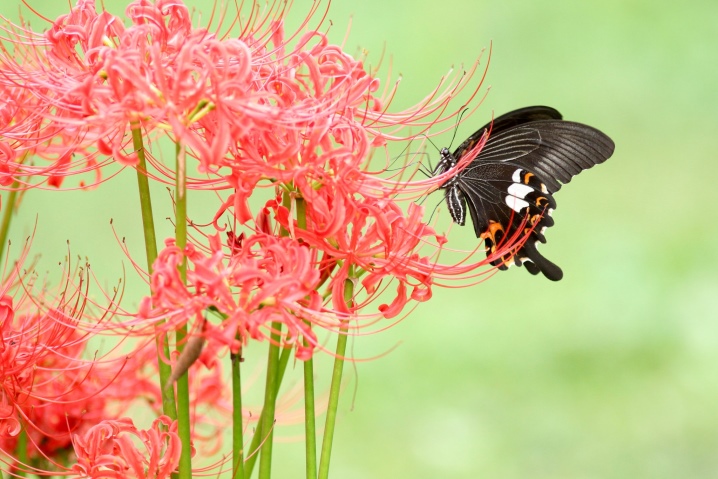
How to grow licoris
There will be no particular hassle with growing a spider lily in a suitable climate. If we compare agricultural technology with other bulbs, then it is similar to planting daffodils or tulips. It is better to immediately choose a place that is sunny or slightly shaded, without stagnant water. The soil will need light sandy loam. Previously, the site is well dug up.
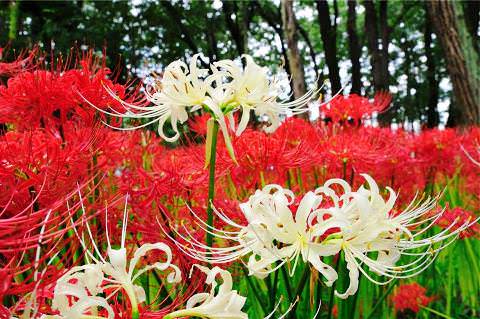
Perennial bulbs are large, the average size is 5 centimeters in diameter. From above, they are covered with dense dark brown scales. They are planted in holes to a depth of 20 centimeters
It is important to leave about 30 centimeters of free space between the plants. After this, systematic moderate watering is required.
As practice shows, the bulbs take root remarkably in the summer. With transplants, it is more difficult, the plant will certainly be capricious and the next year is unlikely to bloom. It will be necessary to plant it, about one new bulb is formed every year, and if it becomes too crowded in the nest, the flowering will be increasingly scarce.
Fertilize the spider lily with any preparations that are suitable for bulbous. The plant is not particularly demanding for moisture, however, during the period of intensive leaf growth and to stimulate flowering, abundant watering is desirable.
Withered foliage is cut off in the fall. It is not worth digging the bulbs for the winter, the beds may not even be covered, however, some growers lay dry foliage or coniferous branches around the perimeter of the roots.
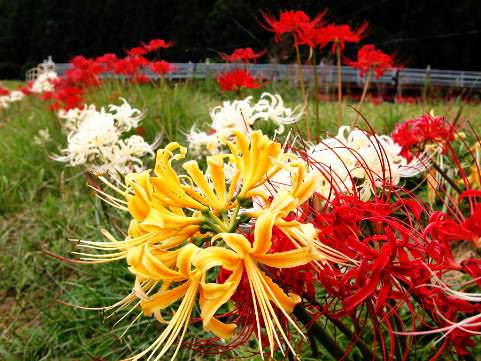
Planting seedlings in open ground
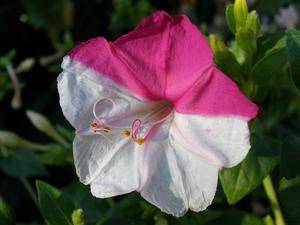 When the threat of frost passes and the soil warms up, The night beauty is planted on flower beds in the garden. The plant is thermophilic, so the soil should warm up well.
When the threat of frost passes and the soil warms up, The night beauty is planted on flower beds in the garden. The plant is thermophilic, so the soil should warm up well.
Since mirabilis grow rapidly, enough space must be prepared for them, otherwise they will "crush" growing crops nearby. Between the rows of plants should be from forty to fifty centimeters.
A few hours before planting, the soil in the pots is well watered. Wells for mirabilis make a little more volume than the roots of a plant together with an earthen lump. The bushes are carefully removed from the peas along with the soil and placed in the prepared holes. Sprinkle the roots with soil mixture and watered.
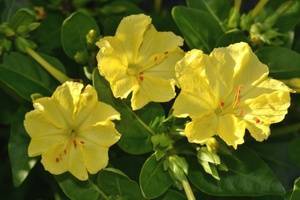 Caring for the plant will not take much time, but some rules must be followed during the growing season:
Caring for the plant will not take much time, but some rules must be followed during the growing season:
Since mirabilis does not like waterlogging, when caring for it, watering is carried out only after the soil dries out. If it rains regularly in summer, then the plants do not need to be watered.
In dry and hot weather, plantings are watered one to three times a week.
When growing plants outdoors after watering, remove the weeds and gently loosen the soil. At the beginning of the growing season, in the middle and at the end of summer, plants are fed with complex mineral fertilizers or compost and humus
It is not recommended to use fresh organic matter.
The second and third top dressing should contain as little nitrogen as possible, otherwise the plants will form leaves and not flowers.
Since mirabilis is grown in gardens as an annual, in autumn, after flowering, the ground part of the plant is cut off and burned. The garden bed where the flowers grew must be dug up. To preserve the bush until next spring, it is dug up and pruned at a height of about ten centimeters. When the stems dry up, they will fall off and only black tubers that look like carrots will remain. The tubers are wrapped in paper, placed in containers and sprinkled with sand. They should be stored at temperatures from +3 to +7 degrees. In spring, tubers can be germinated first. in a pot on a windowsill or immediately plant it on a garden bed in a heated ground.


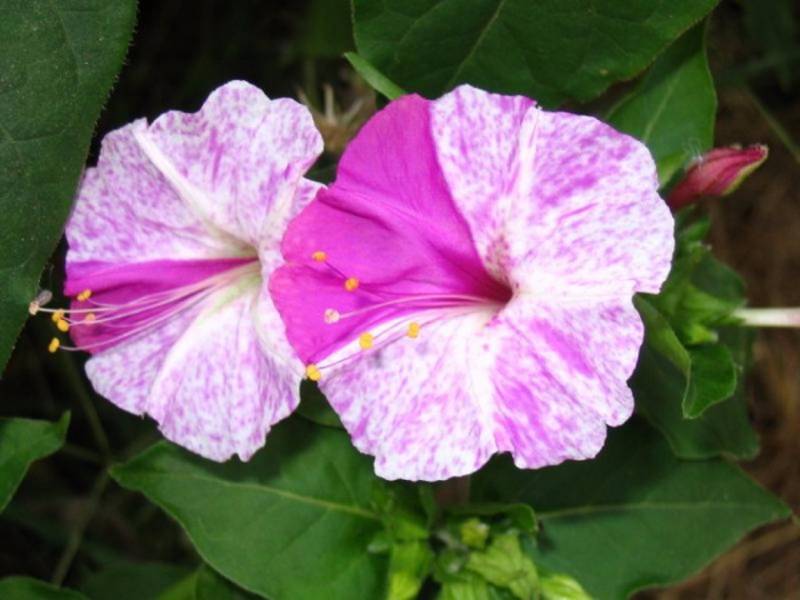
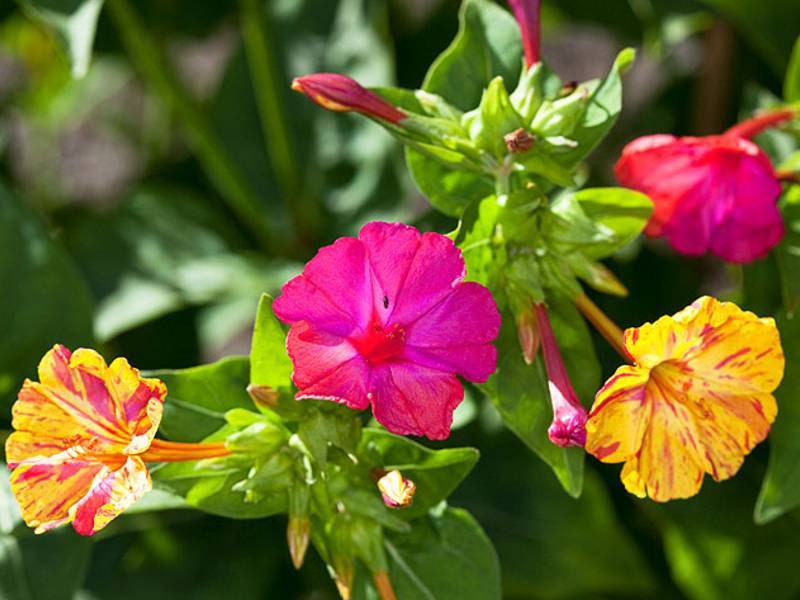
Licorice care in the garden
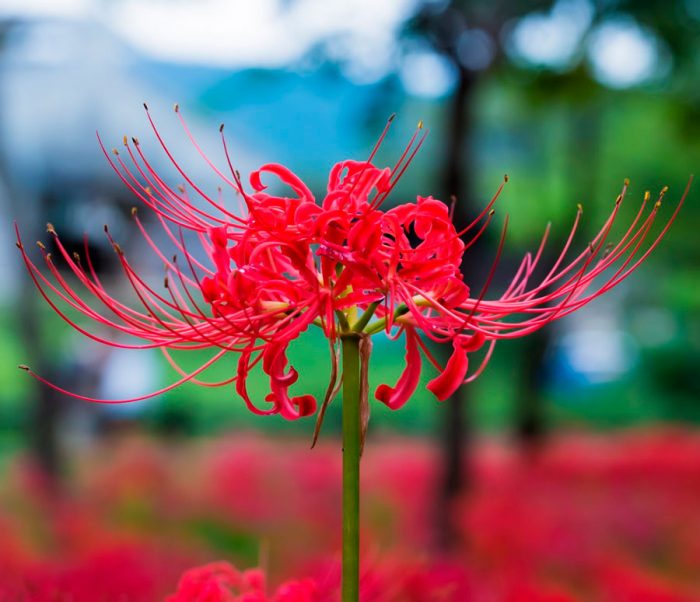
Growing lycoris in your garden is a snap. To do this, he will need to ensure timely watering, weeding, loosening of the soil near the bushes and top dressing. Also, the bushes need preparation for wintering. If necessary, lycoris is transplanted, as well as the destruction of harmful insects.
How to water and feed
Particular attention should be paid to watering lycoris during the intensive growth of leaf plates and peduncles. During this period, the surface of the soil under the plants should be constantly humid, and you should try to avoid the complete drying out of the earth.
During the dormant period, which is observed in winter and summer, it is not necessary to water such a culture.
Such a plant does not need mandatory feeding. If the shrub is effective and healthy, it means that it has enough nutrients. However, if the bushes look depressed or sluggish, then it is recommended to feed them with a special mineral fertilizer for bulbous crops.
Transfer
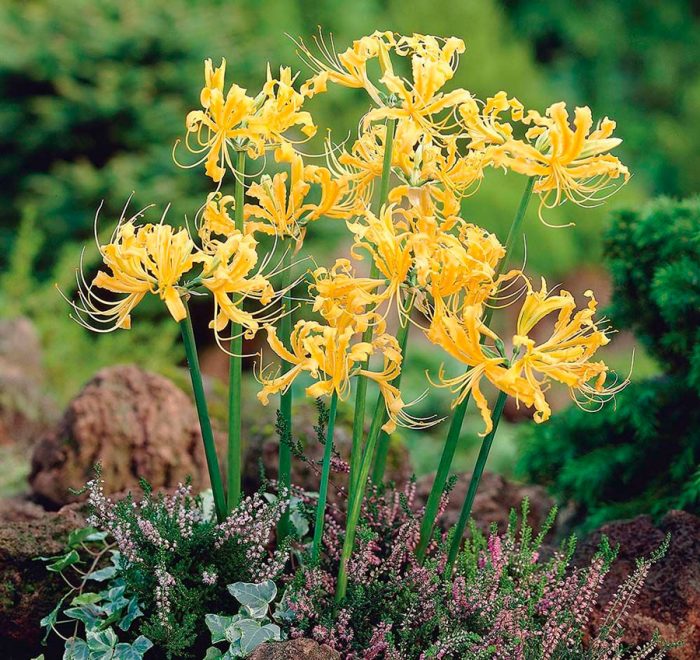
Unlike most bulbous crops, it is not necessary to replant lycoris every year. It can be grown in the same place for about 5 years, but then the bulbs must be removed from the ground, divided and planted in a new place.First you need to start preparing new landing holes. Then the bulbs must be removed from the soil, the children must be separated, while this must be done carefully, and then the places of the breaks must be treated with wood ash or crushed coal. After that, the bulbs are planted in open soil (the planting procedure is described above). If the lycoris is transplanted in the autumn, then the area is not watered. It should be borne in mind that transplanted plants may not bloom for the first 1–2 years after this procedure. You also need to remember that excessively frequent transplants and division of lycoris bushes lead to their strong weakening. It is necessary to work with such a plant with gloves, since all its parts contain poisonous substances.
How to propagate
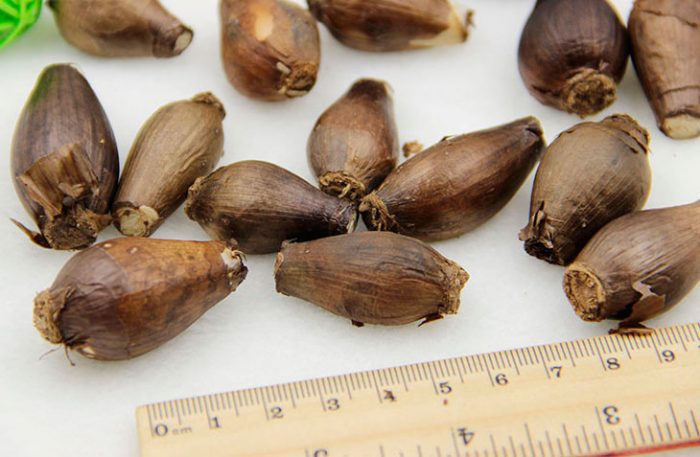
Often, daughter bulbs are used to propagate such a culture. The fact is that it is quite difficult to obtain lycoris seeds, all the more so when you consider that some of the species do not form them at all. It is very simple to propagate such flowers vegetatively, or rather, with daughter bulbs, and how to do this is described above.
After flowering
The formation of leaf blades is observed after the wilting of flowers. In the last autumn weeks, pruning of dried parts of the bush is done. It is not necessary to remove the bulbs from the soil for wintering, since they take deep roots and are not afraid of severe frosts. If the winters in the region have little snow and very cold, then the surface of the site must be covered with a layer of spruce branches or dried foliage. In spring, the shelter is removed from the site.
Diseases and pests
Licorice is highly resistant to diseases and pests. However, daffodil flies can settle on it, in this regard, for preventive purposes, the site is spilled with an insecticide solution during the intensive growth of the bushes.
Description and history
The length of the lycoris leaves reaches 30-60 cm. The width of the foliage is within 1-1.5 cm. The height of erect stems does not exceed 90 cm. Each of the plants is capable of producing 5-7 peduncles. Fragrant flowers are painted in various shades:
- orange;
- yellow;
- golden;
- purple;
- white.

Lycoris
Licorice is naturally endowed with two types of flowers:
- with long stamens, which exceed the dimensional characteristics of the perianths several times;
- with short stamens, which are slightly raised above the petals.
The fruits of the spider lily are three-channel boxes with seeds. Given the low percentage of seed germination, growers recommend vegetative propagation of flowers.
Note! Flowers and foliage of an ornamental culture never meet each other. Why can't flowers and leaves of an amazing flower meet? To explain such a phenomenon and answer a widespread query on the Internet "lycoris meaning of a flower", you can read the legend set forth in the "White Lotus Sutra of the Highest Teaching"
Why can't flowers and leaves of an amazing flower meet? To explain this phenomenon and to answer the widespread Internet request "lycoris meaning of a flower", you can read the legend set forth in the "White Lotus Sutra of the Highest Teaching."
Legend of origin
In ancient times, there were natural spirits that took care of different parts of the magic plant. According to the legend of the lycoris, a spirit named Saga kept the green mass of a spider lily, while Manju tended the flowers. They were forbidden to meet, but the spirits decided to break the will of God and after the very first meeting they fell in love with each other.
The angry God sent a curse on Saga and Manju. From that moment on, the foliage and flowers on the plant could never meet again. As soon as the lycoris flowers begin to bloom, the green mass falls off. At the time of the formation of new leaves, the flowers wither.There is an opinion that after meeting in hell, the lovers vowed to meet each other at the time of reincarnation and never part again. Alas, this did not happen. Everyone in Japan knows this legend.
Interesting! In Japan, flowers associated with the tragic legend grow in the cemetery. They are often used at funerals, because the plant means separation and grief.
Care features
Caring for licoris is quite simple, but it is important to follow some rules.
Seat selection
One of the components of the successful cultivation of lycoris is the correct choice of the planting site. For the plant, you need to create conditions close to its natural environment. A spider lily will grow well in a bright place where there are no drafts and strong winds. The partial shade of large garden trees is also perfect.
Perfect ground
Before planting lycoris, the soil must be weeded and loosened. For planting, use a soil mixture of equal proportions:
- Sand;
- Peat;
- Humus.
What time to plant
It is recommended to plant lycoris in autumn 4 weeks before frost sets in. During this time, the bulbs will have time to adapt to a new place, and their roots will grow. If there is such a need, the planting of the bulbs can be done in spring, but it should be noted that in this case there is a high probability that the flowers will be very sore. The flowering of this plant next year after planting almost certainly will not come, the fact is that it is very moody.
Growing this culture is relatively difficult. To do this, you must carefully choose a site suitable for growing, and the licorice will also need to provide growth conditions that will be very similar to natural ones. The optimal site for growing such a plant is one that is protected from drafts and gusts of wind and is located in the partial shade of large deciduous trees.
How to plant
Before describing the planting process, it is important to remember that all parts of the lycoris are poisonous, therefore, all manipulations must be carried out with gloves. The spider lily bulb should be about 5 cm in size and covered with brown scales
The spider lily bulb should be about 5 cm in size and covered with brown scales.
- Plant the bulb to a depth of 14-15 cm. This will prevent it from freezing.
- Plant the bulbs at a distance of 25-30 cm from each other;
- It is best to plant them in the fall. So they will better take root and adapt to new conditions.
- Flowering usually occurs only in the second year after planting.
Watering
During the growth of leaves and peduncles, watering should be active. Do not allow the soil to dry out. During this period, the ground should be moist. When the plant is resting (after the leaves die off and before the peduncle appears), there is no need to water.
Top dressing
With the successful development and growth of the plant, if there are no problems in appearance and flowering, then additional feeding is not needed.
Pruning and preparing for winter
Only dried leaves should be cut off from the plant in the fall. He does not need any other trimming.
Having rooted the bulbs deep in the soil, they are left there for the winter, and they are not afraid of frost. Some growers advise only to cover them with coniferous branches or dry grass.
Transfer
The spider lily does not like to change the place at all. It grows well in one place for 5 years. After this time, e can already be transplanted. The transfer is carried out in the same way as the landing.
After flowering
The formation of leaf blades is observed after the wilting of flowers. In the last autumn weeks, pruning of dried parts of the bush is done. It is not necessary to remove the bulbs from the soil for wintering, since they take deep roots and are not afraid of severe frosts. If the winters in the region have little snow and very cold, then the surface of the site must be covered with a layer of spruce branches or dried foliage. In spring, the shelter is removed from the site.
Seed planting
For the seed method of reproduction of lycoris, it is necessary to adhere to the recommendations of experts regarding the implementation of planting work:
- A prepared container with drainage holes is filled with a mixture of perlite, fertile soil, vermiculite and peat moss.
- The seed is scattered over the surface of the soil mixture and sprinkled with a small layer of soil.
- The soil is moistened, and the container is covered with a film material.
- Containers with plantings are transferred to a room where the temperature reaches 21-24 ° C.
After 2-3 weeks, seedlings can be expected to appear.
Note! Lycoris seeds have low germination
Care features
Caring for licoris is quite simple, but it is important to follow some rules.
Seat selection
One of the components of the successful cultivation of lycoris is the correct choice of the planting site. For the plant, you need to create conditions close to its natural environment. A spider lily will grow well in a bright place where there are no drafts and strong winds. The partial shade of large garden trees is also perfect.
Perfect ground
Before planting lycoris, the soil must be weeded and loosened. For planting, use a soil mixture of equal proportions:
- Sand;
- Peat;
- Humus.
How to plant
Before describing the planting process, it is important to remember that all parts of the lycoris are poisonous, therefore, all manipulations must be carried out with gloves. The spider lily bulb should be about 5 cm in size and covered with brown scales. The spider lily bulb should be about 5 cm in size and covered with brown scales
The spider lily bulb should be about 5 cm in size and covered with brown scales.
- Plant the bulb to a depth of 14-15 cm. This will prevent it from freezing.
- Plant the bulbs at a distance of 25-30 cm from each other;
- It is best to plant them in the fall. So they will better take root and adapt to new conditions.
- Flowering usually occurs only in the second year after planting.
Watering
During the growth of leaves and peduncles, watering should be active. Do not allow the soil to dry out. During this period, the ground should be moist. When the plant is resting (after the leaves die off and before the peduncle appears), there is no need to water.
Top dressing
With the successful development and growth of the plant, if there are no problems in appearance and flowering, then additional feeding is not needed.
Pruning and preparing for winter
Only dried leaves should be cut off from the plant in the fall. He does not need any other trimming.
Having rooted the bulbs deep in the soil, they are left there for the winter, and they are not afraid of frost. Some growers advise only to cover them with coniferous branches or dry grass.
Transfer
The spider lily does not like to change the place at all. It grows well in one place for 5 years. After this time, e can already be transplanted. Transplanting is carried out in the same way as planting (see section "How to plant").
Reproduction
Lycoris seeds are rarely propagated, since only some species give productive seeds. Most often, the vegetative method is used for reproduction.
Each year, the plant grows several daughter bulbs. At the end of the season, the babies are ready for independent growth and can be separated. However, it is often impossible to divide the plant, since it weakens and may not bloom for a couple of years.
- After flowering, dig out the bulb;
- Carefully separate them from each other;
- After separation, plant the daughter bulb in a new place, and plant the mother bulb back.
Pests and diseases
Licorice is a very resistant plant and does not succumb to the attacks of pests and diseases. He rarely gets sick. The only pest that can harm the plant is the daffodil fly. In case of infection, treat the flower and soil with an insecticide.
Features of care for lycoris
In order for the plant to please with abundant flowering, and not be susceptible to diseases, it is important to observe the basic rules of agricultural technology when growing. Below are the features of caring for a spider lily
Lighting
When choosing a landing site, you should give preference to well-lit areas. When growing flowers in apartment conditions, it is necessary to provide the bushes with additional scattered supplementary lighting. For this purpose, phytolamps should be purchased.
Preparing for winter
At the beginning of autumn, when flowering is completed, the aboveground parts of the plants die off. They can be cut off without regret. Flower bulbs do not need to be dug out. Watering stops completely, and the soil where the bulbs remain is covered with a small layer of dry foliage or needles. The layer thickness should be up to 9-12 cm.
Temperature
The ornamental culture belongs to the thermophilic category. It is advisable to keep the room temperature within 21-27 ° C. In open ground, seedlings can be planted only during the period when the threat of night frosts has passed.
Air humidity
The recommended humidity level in the room where the flowers are grown is in the range of 50-55%. Excessive dryness negatively affects the appearance of plants, therefore experts recommend using moisturizers during especially dry periods. You can also systematically spray spider lilies.
Note! Throughout the year, the plant can go into dormancy twice - in summer and autumn.
Top dressing
Before planting lycoris bulbs on an open bed, you should take care of introducing organic fertilizing into the soil. After that, it is recommended to feed the flowers with liquid mineral fertilizer every 14 days.
Watering mode
It is very important to systematically moisten the soil in which the ornamental culture grows. It is impossible to allow the soil to dry out
It is necessary to moisten the ground 2-3 times a week. After the foliage begins to wither, the plant can not be watered.
The soil
In order to ensure rapid growth and active development of licorice, it is necessary to select areas with loose, light or loamy soil for planting seedlings / bulbs. To grow seedlings, you should use specialized store soil mixed with a small amount of peat.
Care features
The most important rule is that you can only work with the plant with gloves. All parts of the flower are poisonous and can cause poisoning.
In the spring-summer period, lycoris must be watered. He especially needs watering during the formation of leaves and peduncles. The soil must be constantly moistened (4-5 times a week), preventing the soil from drying out.
When the lycoris is immersed in dormancy (after flowering and before the formation of leaves and buds), it is moderately watered 1 time. In winter, after snow falls, the procedure is stopped.
The subcortex is carried out every 2 weeks during the growing season. From the beginning of leaf growth, they are fed with water-soluble nitrogen fertilizers. When the buds appear, a high potassium supplement is used.
Also, for abundant flowering, you can put a fluorescent lamp per day for 2-3 hours at the beginning of flowering.
The plant should be pruned only in the fall, after flowering. Cut off the dried leaves with sharp scissors. You don't need to clean up anything else.
Annual transplants, like many bulbous plants, the plant does not require. It is enough every 5 years, after flowering, to dig out the bulb and separate the children from it with the help of a sharp knife. The place of the break of the onion is sprinkled with coal powder or ash.
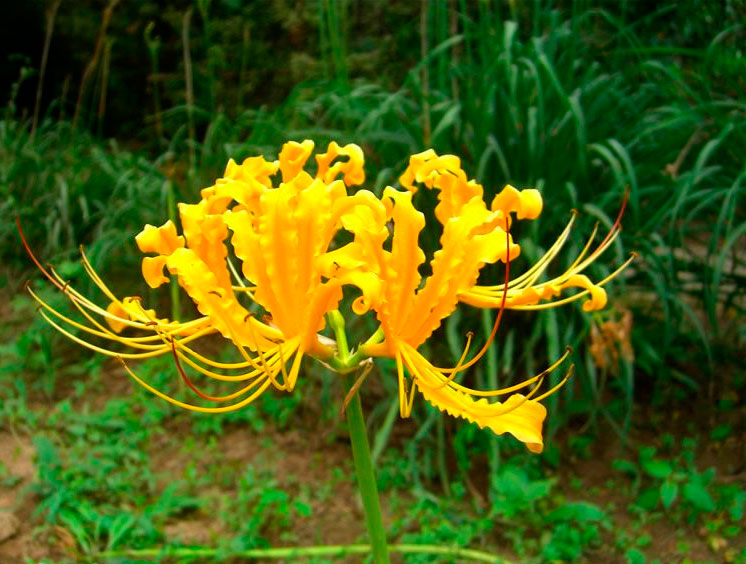
Growing problems
Prolonged exposure to sunlight can cause burns. This is bad for the general condition of the flower. The damaged areas are cut with scissors.
Lycoris must be protected from constant winds and drafts.
Illiteracy in care not only increases the chance of disease, but also reduces the splendor of the inflorescence.
Dichondra in landscape design
Landscape designers often use the dichondra plant for decoration:
- terraces;
- summer cottages;
- fences;
- arbors;
- balconies;
- loggias.

Perennial in landscape design
Often, the plant can be found in the garden, where the perennial is lined like a carpet. Similarly, you can decorate the paths along the pool and flower beds.
Dichondra ampelous has the ability to effectively isolate a number of growing flowering plants, of the type:
- petunias;
- roses;
- dahlia;
- asters;
- calibrachoa.
Advice! You can plant a perennial near conifers. However, landscape designers consider the best composition to be planted nearby varieties of dichondra Silver and Emerald Falls. The foliage of plants, mixing with each other, creates a unique image.
Dichondra Silver Falls is considered a versatile and graceful ornamental plant. Caring for dichondra is quite simple, which is undoubtedly an advantage. The flowing waterfall created by the silvery foliage allows you to achieve light coolness among the bright floral compositions of the summer garden. Having grown such a flower at home, you can effectively decorate the interior.
Licorice care in the garden
Growing lycoris in the garden.
Planting lycoris and caring for this exotic plant in the open field will not require much effort. You will have to perform a few simple manipulations: water the plant, loosen the soil around it, remove weeds, apply fertilizers and prepare the licoris for winter. From time to time, you have to transplant the plant and destroy the pests that attack it.
In the photo: Growing lycoris in the garden
Watering and feeding lycoris.
Lycoris especially needs watering during the period of active growth of peduncles and leaves. At this time, the soil on the site should be regularly moistened, preventing the soil from drying out. The soil should be slightly moist at all times. When the lycoris is immersed in rest, and the plant rests not only in summer, but also in winter, watering of the soil is stopped.
Fertilizing the area with lycoris is not an obligatory procedure: if your lily has a healthy and beautiful appearance, then it has enough nutrition. But if you notice some lethargy or depression of lycoris, apply mineral fertilizers to the soil for bulbous crops.
Lycoris transplant.
An annual transplant, like many bulbous plants, does not require lycoris, it can grow in one area for up to 5 years, but then the bulbs still need to be dug up, divided and transplanted.
First prepare a new site for the lycoris, then dig up the bulbs, carefully separate the children from them, sprinkle the breaks with coal powder or ash and plant the planting material in a new place, observing the procedure already described by us. If the transplant is carried out in the fall, the area is not watered.
Keep in mind that lycoris may not bloom for one to two years after transplanting. Do not divide the plant too often; this weakens it. All parts of lycoris are poisonous, so work with gloves.
In the photo: How to grow lycoris from bulbs
Reproduction of lycoris.
Most often, lycoris is propagated vegetatively, that is, by daughter bulbs, since it is difficult to obtain lycoris seeds: many plant species simply do not form them. The method of reproduction by children is simple to perform, and we have just described it to you.
Licorice after flowering.
After the lycoris flowers wither, its leaves will begin to form. At the end of autumn, dry plant organs should be removed, but excavated bulbs for the winter not necessary: they take deep roots and are not afraid even of severe frosts. If a snowless cold winter is expected, cover the area with a layer of dry leaves or spruce branches. With the onset of spring, the shelter can be removed.
Description
Licorice does not grow tall, its height reaches no more than 70 cm.
- Refers to heat-loving plants. From a small onion, several narrow leaves are formed in spring, reaching a length of 35-45 cm.
- The color of the leaf is bright green, until they die off. The leaves die off in July, making room for the peduncle.
- It grows to almost 70 cm in height and has a fleshy tissue structure.
- At the top of the peduncle, an inflorescence of very large flowers is formed. From one planted onion, 5-7 buds develop on one flowering stem.
- The blossoming of the buds falls on September, by which time all the leaves have already disappeared. Only blossoming, very unusual and beautiful flowers remain, exuding a pleasant aroma.
- According to the size of the stamens, the flowers are divided into two groups: in one, the stamens are very long, protruding far beyond the petals. In another group, the stamens are almost the same size as the petals.
- There are only a few colors in Lycoris: white, yellow, red and orange tones.
- The fruits are bolls with three channels. Each channel contains very small seeds, they are black in color. Only a few species are capable of seed propagation.
Lycoris species
There are twenty known species of lycoris, but only three species are cultivated.
The species of lycoris scaly is well known in Japan.
A rosette of leaves is located at the very surface of the earth.
Leaves are bright, green, narrow (3cm) and long.
At the end of summer, an inflorescence begins to bloom from a long flowering arrow. Each inflorescence blooms with 8-9 flowers.
The petals are oval, with pale lilac shades. The upper part of each petal is bent back; there are only a few stamens that do not extend beyond the petals. They are in the center of the flower along with the ovary. Lycoris blooms for two weeks.
A perennial with a growth of 35 to 70 cm, after the withering away of long narrow leaves, it releases a flower arrow.
Terracotta, sometimes pink color of large inflorescences of radiant lycoris adorn the autumn park.
The petals have very narrow and long antennae that deviate to the side. The middle is decorated with short and wide processes-petals, forming a bundle.
A short, compact flower with small and narrow leaves, blood-red lycoris.
The leaves bloom in early spring, and in the first month of summer they already turn yellow. The leaves are replaced by a massive peduncle, which produces about six medium-sized inflorescences. The petals are bright red.

Care features
Licoris is a flower that does not cause much difficulty in leaving, even for beginners. However, there are some rules that allow you to grow this exotic plant on your backyard:
- The lily should grow in a well-lit area, but should not be exposed to direct sunlight.
- If you grow a flower indoors, in the spring it will need additional lighting.
- The most suitable temperature range for the plant would be +20 to +27 ° C.
- The plant needs regular watering. The soil should be moistened every time the top layer dries out. However, with an excess of moisture, the root system will rot. In winter and summer, between the appearance of leaves and flowers, the plant is given rest and watering is minimized.
- In spring and August, before flowering, the plant is fed with organic fertilizers. You need to apply dressing in a diluted form under the root of the flower. It is not recommended to overfeed the lily with nitrogenous compounds.
- In the fall, after flowering ends, all dried foliage and stems will need to be removed. To protect the bulbs from frost, you can cover them with spruce branches and fallen leaves.
This culture is practically not susceptible to pests and diseases. In some cases, it is possible to be affected by a narcissus fly. To prevent, you can water the area with a special insecticide.
Flower vatnik: rules for planting and caring for a plant
Reproduction methods
There are several methods for breeding a spider lily, but not all of them are used in gardening and are effective. So, for example, the seed propagation method is suitable for only a few varieties of lycoris.
In order to be sure of the result, it is recommended to propagate the spider lily in a vegetative way. Each year, each flower produces several additional bulbs (also called daughter bulbs). After the end of the season, they can be separated, since at this moment they are already ready for independent growth and development. After flowering, you need to dig out the bulb and separate the formed parts from it.
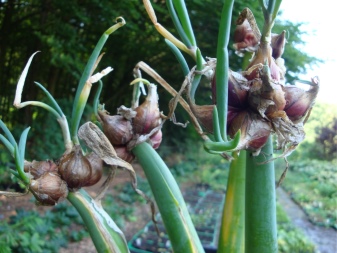

Remember that such division should not be done constantly, as it can have a detrimental effect on the ability of the parent flower to bloom.


